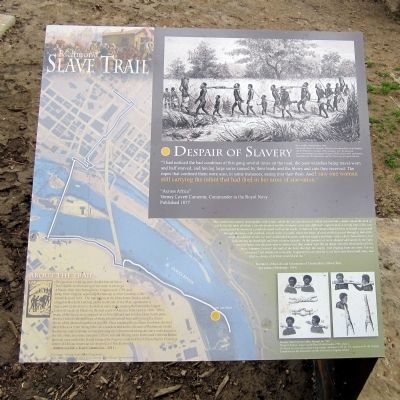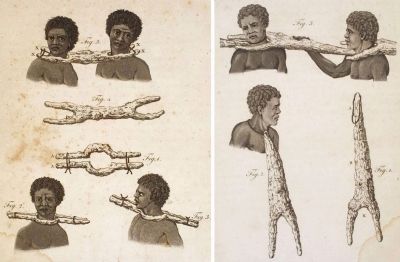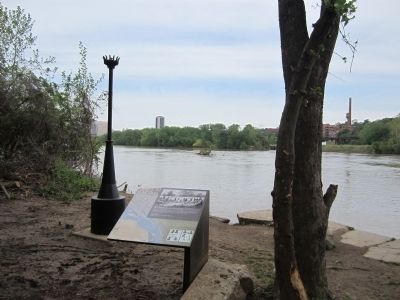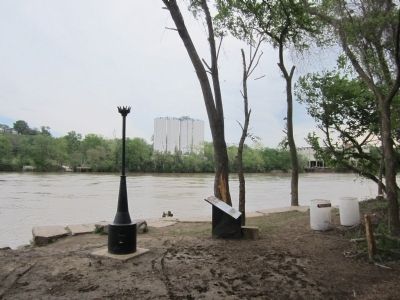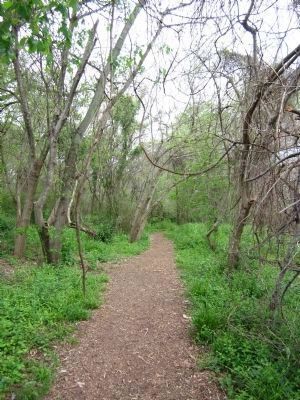Manchester in Richmond, Virginia — The American South (Mid-Atlantic)
Despair of Slavery
— Richmond Slave Trail —
“Across Africa”
Verney Lovett Cameron, Commander in the Royal Navy
Published 1877
“The women were merely tied together with a rope, about the size of a bed cord, which was tied like a halter round the neck of each; but the men, of whom I was the stoutest and the strongest, were very differently caparisoned. A strong iron collar was closely fitted by means of a padlock round each of our necks. A chain of iron about a hundred feet in length was passed through the hasp of the padlock, except at the two ends, where the hasps of each padlock passed through a link of the chain. In addition to this, we were handcuffed in pairs. In this manner, we were chained alternately by the right and left hand; and the poor man to whom I was thus ironed wept like an infant when the blacksmith with his heavy hammer, fastened the ends of the bolts that kept the staples from slipping from our arms. For my own part, I felt indifferent to my fate. It appeared to me that the worst had come that would come, and that no change of fortune would harm me.”
Narrative of the Life and Adventures of Charles Ball, a Black Man
3rd edition (Pittsburgh, 1854)
About the Trail
Designed as a walking path, the Richmond Slave Trail chronicles the history of the trade in enslaved Africans from their homeland to Virginia until 1778, and away from Virginia, especially Richmond, to other locations in the Americas until 1865. The trail begins at the Manchester Docks, which, alongside Rocketts Landing on the north side of the river, operated as a major port in the massive downriver slave trade, making Richmond the largest source of enslaved blacks on the east coast of America from 1830 to 1860. While many of the slaves were shipped on to New Orleans and to other Deep South ports, the trail follows the footsteps of those who remained here and crossed the James River, often chained together in a coffle. Once reaching the northern riverbank, the trail then follows a route through the slave markets and auction houses of Richmond, beside the Reconciliation Statue commemorating the international triangular slave trade and on to the site of the notorious Lumpkin’s Slave Jail and leading on to Richmond’s African Burial Ground, once called the Burial Ground for Negroes, and the First African Baptist Church, a center of African
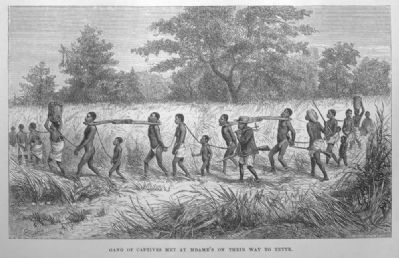
2. Slave Coffle, Central Africa, 1861
David and Charles Livingstone, Narrative of an Expedition to the Zambesi and its Tributaries (London, 1865), facing p. 356. As shown on www.slaveryimages.org (image reference C019), sponsored by the Virginia Foundation for the Humanities and the University of Virginia Library.
Title image: “After the Sale: Slaves Going South”, 1853, Painted from live by Eyre Crowe, courtesy the Chicago History Museum
Erected 2011 by Richmond Slave Trail Commission. (Marker Number 3.)
Topics. This historical marker is listed in these topic lists: Abolition & Underground RR • African Americans. A significant historical year for this entry is 1877.
Location. 37° 31.331′ N, 77° 25.21′ W. Marker is in Richmond, Virginia. It is in Manchester. Marker can be reached from Brander Street, half a mile east of Maury Street. Touch for map. Marker is in this post office area: Richmond VA 23224, United States of America. Touch for directions.
Other nearby markers. At least 8 other markers are within walking distance of this marker. Mechanics of Slavery (within shouting distance of this marker); Crossing the Atlantic (about 400 feet away, measured in a direct line); People-Technology-Commerce-Warfare (about 500 feet away); Up-River Venture (about 700 feet away); Atlantic Sturgeon (approx. 0.2 miles away); The Navy Yard of the Confederate States (approx. 0.2 miles away); Ancarrow's Landing (approx. 0.2 miles away); Creole Revolt (approx. 0.2 miles away). Touch for a list and map of all markers in Richmond.
Credits. This page was last revised on February 1, 2023. It was originally submitted on April 21, 2011, by Bernard Fisher of Richmond, Virginia. This page has been viewed 2,086 times since then and 68 times this year. Photos: 1, 2, 3, 4, 5, 6. submitted on April 21, 2011, by Bernard Fisher of Richmond, Virginia.
